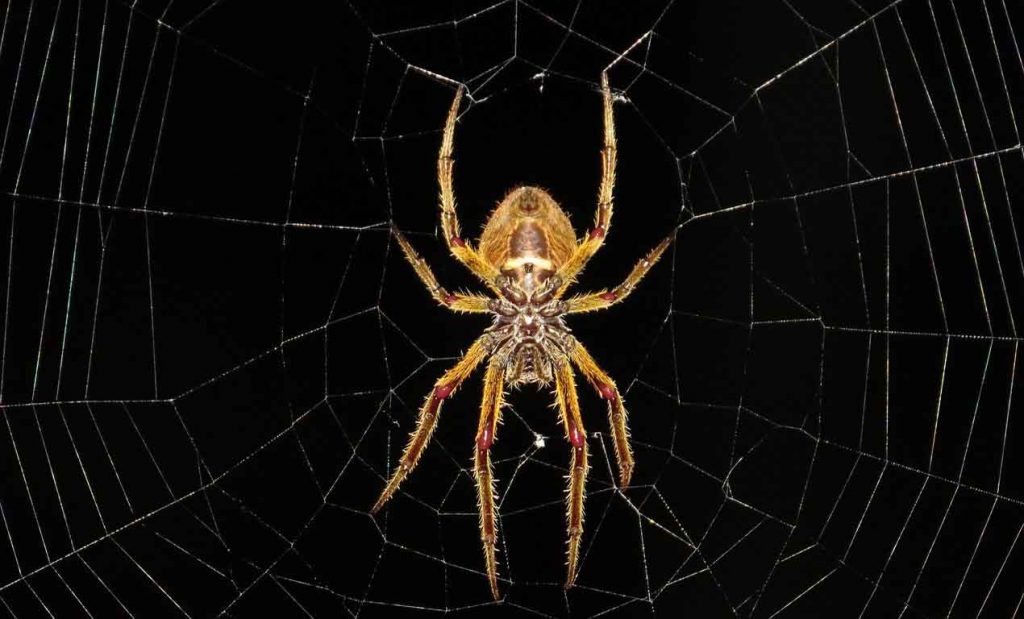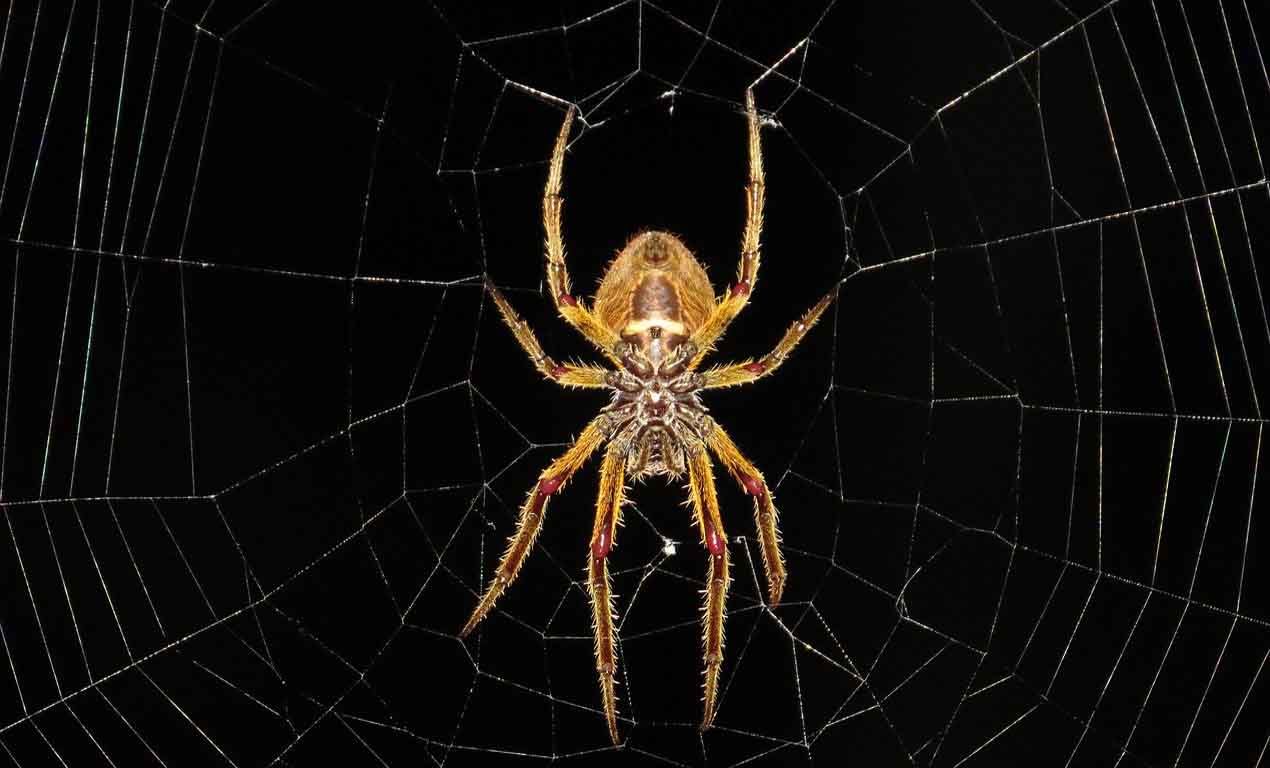
 There are more than 48,000 spider species and 120 families, found across the globe. Spiders are air-breathing arthropods, have eight legs, and chelicera with fangs in front, which can inject venom. Spiders are both diurnal and nocturnal, depending upon the species. Let’s discuss the nocturnal spiders.
There are more than 48,000 spider species and 120 families, found across the globe. Spiders are air-breathing arthropods, have eight legs, and chelicera with fangs in front, which can inject venom. Spiders are both diurnal and nocturnal, depending upon the species. Let’s discuss the nocturnal spiders.
Orb-weaver spider is one species that is very active at night. We shall understand a little more about them. They belong to the Araneidae spider family and get well known to build spiral, wheel-shaped webs, found in gardens, parks, fields, and forests.
So, are spiders more active at night? The answer is yes, but it depends upon the species. Not all spiders are active at night. There are some spider species that are nocturnal, and some are diurnal. Few spiders prey and do all of their activities at night, and few of them do it in the morning.
Nocturnal Or Diurnal
There are raging discussion forums on whether spiders are nocturnal or diurnal. The answer is that this depends mainly on spider species. Some are strictly nocturnal, while some are diurnal. Some nocturnal species have got observed to have become diurnal too.
Eyesight:Spiders with better vision, prey during the day and rest at night and vice-versa. There are spiders which have eight eyes, six, four and so on. They always have even a pair of eyes. Those with a lesser number of eyes prey using their sense of vibration. This gets felt by their body parts and also the silk attached to the web or on their legs.
Predators:Spiders have opted for nocturnal habitat, to avoid their predators, who are active during the day. However, their prey also is in large numbers during day-light. Hence, they decide on the trade-off and acclimatize accordingly.
UV rays:The UV rays from the sun affect the quality of silk that gets produced. Spiders who require the UV rays for their silk to be strong for their predatory and defense requirements are more active during the day. Those spiders whose silk-producing gel does not have much impact concerning UV rays have developed into diurnal species.
Will Spiders Crawl On You At Night?
 In general, spiders avoid humans, but If you have too many spiders in your house, then there are some possibilities that they can crawl on you at night.
In general, spiders avoid humans, but If you have too many spiders in your house, then there are some possibilities that they can crawl on you at night.
They don’t do it for revenge or to bite a human. It can happen only by accident, and spiders may not be aware that they are climbing on you, although the chances of a spider biting you at night are very less.
If you are sleeping motionlessly, then the spider will go away, but if you are moving or rolling, then it may be bad for the spider as it can die because of it.
Usually, a spider doesn’t like to come down from the walls. Walls are a safe place for them. They only do it if they feel like they need to make their nest far away from the other spiders, which can be their competitors.
Not all spider bites human even when provoked. Spiders try to avoid humans by all costs, but some spiders can be dangerous, for example, tarantula, black widow.
If these poisonous spiders are inside your house, then it’s a matter of concern because it doesn’t matter whether you are awake or sleeping, they are dangerous and potentially life-threatening.
But the chances of seeing these spiders inside your house are very less. Unless you have these spiders in your region, there is no way you are going to see them inside your home.
Even if they are inside your house, they won’t crawl on you when you are sleeping because, as I mentioned before, spiders avoid humans.
There is a spider named Orb-weaver spider, or the garden spiders they are active from late evening onwards. They rest during the day.
First, they eat their entire web or its remnants, which got created the previous day. Rest for an hour or so.
They then construct a new web in a similar site for new prey to get trapped.
They don’t do any harm to humans.
So, in one word, you don’t need to worry about spiders crawling on you at night.
Some Ways To Get Rid Of Spiders

Here are some ways to get rid spiders:
1: Use A Glue Trap: Glue traps work well to get rid of them. Once a spider steps on a glue trap, it won’t be able to come out, and they will die. It can trap multiple spiders at the same time. Once they are trapped or dead, you can throw away the trap.
Just place the trap where you see the maximum number of spiders, and you’ll be ready to go.
2. Use Peppermint Oil: Peppermint oil also works well against spiders. The strong smell from peppermint oil repels them and will reduce the infestation.
3. Use Vinegar: The acetic acid inside the vinegar will instantly kill them. Mix equal parts of water and vinegar and spray it directly over them to get rid of them. Vinegar scent will disappear as soon as the vinegar evaporates.
4. Use Diatomaceous Earth: Diatomaceous earth is very effective against them. When spiders come in contact with diatomaceous earth, it punctures their body, and their bodily fluid starts leaking. This doesn’t happen overnight, but it happens eventually. Spread a fine layer of diatomaceous earth and put it everywhere you see spiders.
5. Vacuum The Spiders: Buy a vacuum cleaner and vacuum them to get rid of them. Once, the spiders are inside the vacuum cleaner. They will die. You can vacuum a vast number of them at a single time.
Is It A Good Sign If Spiders Crawl On You?
There is a belief that if a spider crawls on you, then you are going to have a good day. However, this is just a myth, and there is no such scientific evidence that they bring good luck.
If a spider crawls on you, it means there are too many spiders in your house, and you need to take care of that. Just by thinking about good luck, you cannot let the infestation increase as it will lead to more problems.
Normal house spiders don’t do any harm to human, and many people freak out just by looking at them and by any chance if these spiders get onto someone scared of them then, he or she can have a panic attack, which can be dangerous.
So, without getting mixed up in the superstition, it’s better to get rid of them.
Some Facts About Various Spider Species

Huntsmen spider: These are not dangerous since they would run away when a gigantic human form approach. They are quite useful at home since they prey on small insets and would keep your house clean.
Wolf spider: Their main differentiating features are their eyes. They have eight eyes, with four at the bottom and two each, one above the other. They are dark brown and have light patterns on their thorax and abdomen. They are active hunters, mostly found on the ground, outdoors. They are active at night. They do not build webs but chase their prey and kills them.
Cobweb spider: Humans most commonly see them. They get noticed in your damp basement, in caves, or your garden. They weave a cobweb with their fine silk and wait in nearby crevices to snare prey. These are also known as common spiders. They are yellowish-brown in color with an elongated abdomen.
Brown recluse spider: These get colored light to dark brown, with dark shaped violin on their back. They get generally found outdoors. Indoors, you can find them under wooden crates, furniture, and fixtures. They love dark recesses, including closets and shoes. They bite in defense and may require medical treatment if the bite results in fever, restlessness, and sleeping difficulties. Males travel further from their habitat in search of food.
Black widow spider: They are mostly found outdoors, under woodpiles and firewood. Shiny black, these spiders have a tell-tale red hour-glass marking on their back. Males hardly bite, but the female attack if they get threatened, especially if they are guarding their eggs. In case of fever, nausea, and high blood pressure, it’s prudent to refer to a doctor. They are not cannibalistic during mating.
Jumping spider: They are dark, small, and has short legs. They have the best vision among the spider fraternity and see up to eighteen inches away. They build short webs to retreat into. They prey around doors and windows, where most of their food gets located. They are day-light spiders and love to be in the sunshine. Outdoors, they get found on tree barks, walls, fences, and under stones. Their bite is non-poisonous.
Long-bodied cellar spider: These spiders have a small body and long, thin legs. They are pale yellow to light brown. They get found in humid spaces, like the cellar, basement, in your garage, or warehouses. They are venomous, but their mouthparts cannot bite into human flesh, hence no danger from these specimen of spiders.
Tarantula spider: They live in warm climates and get considered as the most venomous. They belong to the Theraphosidae family and are generally large and hairy. They do not bite humans unless they get provoked. Their bite is similar to a bee sting, and if there are any physical discomfort, seek medical attention. Due to their docile and individualistic nature, tarantulas get considered pets.
Camel spider: Though this species is from the arachnid family, they are not spiders. They are from the solifugae order, have eight legs, and a pair of sensory pedipalps. They are large, tan-colored and hairy, and can reach up to six inches in length. They are carnivores and feed on lizards, small birds, and rodents. However, they are not harmful to humans. They are quick runners and adapted to living in desert conditions.
Hobo spider: These are outdoor creatures found near the railroad, construction sites, warehouses, or pumping stations. You can find them under rocks, ledges, and caves, and do not attack humans. They have a brown body, long legs, and grey abdomen with yellowish markings. They construct funnel or tube-shaped web to hide. They run very well but cannot climb since they are terrestrial creatures.
Golden silk spider: These are giant orange and brown spiders, found mostly in forests and woods. They have tufts of bristles on its legs and produce sticky webs among trees and shrubs. They feed on insects like wasps, flies, and moths. They are not harmful to humans, and only bites humans, in self-defense.
Redback spider: They are also known as Australian black widows and gets considered as very poisonous. They live near human settlements in untidy webs. They feed on insects by snaring them in their webs and stinging their prey repeatedly. Bites of these spiders on humans are painful, leading soreness, nausea, and headache. If symptoms persist more than 24 hours, medical attention is advisable.
Goliath birdeater spider: These belong to the tarantula family and gets considered as the giant spider in the world. Contrary to their name, they rarely prey on birds. They are cannibalistic during mating. Females live up to 25 years, while males survive up to 6 years.
Brazilian wandering spider: These spiders get known as armed spiders. They are large brown with black spots on the underside of their abdomen. They are most dangerous in the world, with their venom causing discomfort to humans, especially to children.
Conclusions
Spiders are both nocturnal and diurnal; however, their activity depends mostly on their habitat. Though most spiders get active at night, some are strictly day creatures.
Welcome to my blog. I have been doing pest control for years since my house, garden and pets were always attacked by various kinds of pests and as a result I had to know proper pest control techniques that works. In this blog I share all the tips and tricks that I know and I hope you’ll find it helpful.
